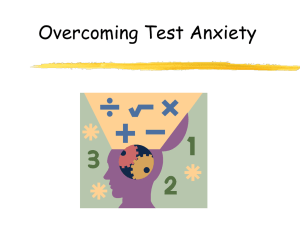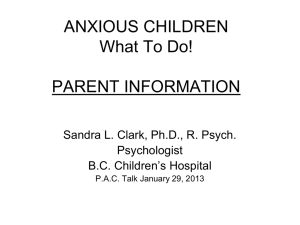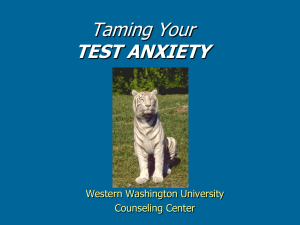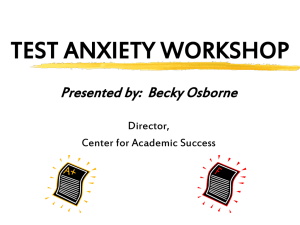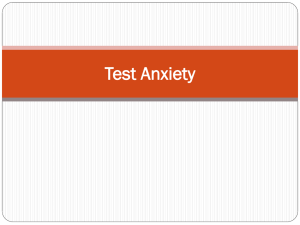Anxiety & Relaxation Workshop
advertisement
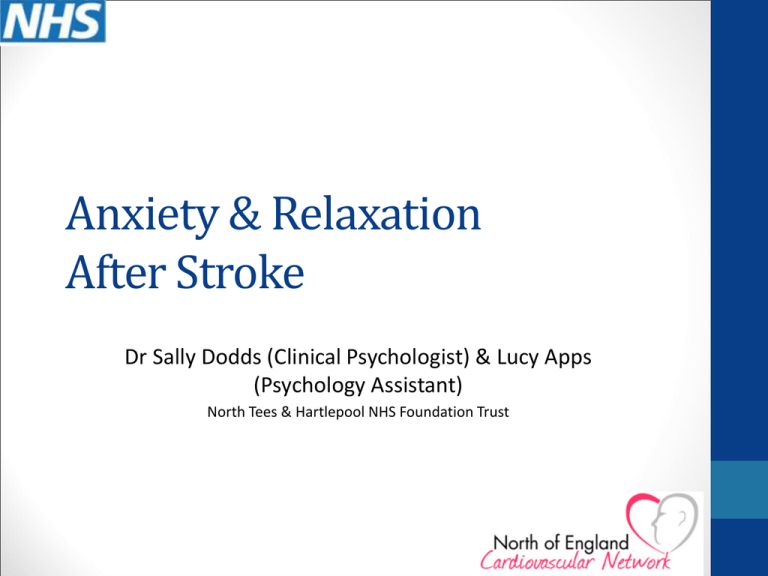
Anxiety & Relaxation After Stroke Dr Sally Dodds (Clinical Psychologist) & Lucy Apps (Psychology Assistant) North Tees & Hartlepool NHS Foundation Trust What we’ll cover Anxiety • • • • Overview After Stroke How you can help Exercise Relaxation • • • • Why ? How and when Tips Demonstration Quick Overview of Anxiety Symptoms Biological Cognitive Psychological Behavioural • Dry Mouth • Shaking • Sweating • Heart racing • Breathing • Self as vulnerable •World chaotic • Difficulties concentrating • over interpretation of threat • Anxiety • Irritability • Feeling on edge • Avoidance • Increased dependency • Wish to escape Anxiety in Stroke Types & Prevalence Effects • 1 in 10 premorbid anxiety • Panic attacks • OCD • Phobias • After stroke 22% to 28% • Generalised Anxiety Disorder (25%) • PTSD (5-30%) • Health Anxiety • Social Anxiety • Agoraphobia • • • • • • • Reduced concentration Interrupted sleep Impacts on rehabilitation Relationship difficulties Reduced social contact Burden on services Poorer outcomes esp. with comorbid depression Associated Fears • • • • • • • • • • • Falling (88%) Having another stroke Dying (in sleep) Incontinence Reaction of others Going home Disability Not being able to cope Not getting better Over-exertion Failure to meet pre-stroke expectations • Dependence • Vulnerability • Not receiving enough care • Restriction & overprotection • Public transport • Crossing the road • Travelling • Speaking on the phone • Social situations • Work What you can do WHY? • Everyone in stroke team should be able to support those with psychological issues (NICE; RCP) • Stepped Care Approach • Model • • • • HOW? Be aware of types of anxiety Screening Onward referral Understand and assist at levels 1 or 2 How to Screen for Anxiety • Routine mood assessment (NICE & RCP) • Hospital Anxiety & Depression Scale (HADS-A) • Behavioural Outcome of Anxiety (BOA) When to refer on • • • • HADS is not perfect! Use clinical judgement & knowledge of patient Anxiety is normal after a stroke – notice, explore, monitor Check out how they’re feeling • • “You just looked really worried. Can you tell me what went through your mind?” “ when you just had that thought of…..did you notice anything about your body?” • Ask family • “Are they usually anxious, what makes them tense, what helps?” • If anxiety persists consult a psychologist • Be aware of your local pathways for referral Understanding Anxiety • Exercise in twos/small groups • Case Study • Think about what might be going on for Bob and what you can do – use tools provided to help • 10 minutes • We’ll then introduce a specific intervention you can try BP & Hyper tension Anxiety & Stress Depression Relaxation Neuro Rehab Cardiac Rehab Sleep & Attention Pain & Mobility Relaxation in Stroke • Local Project funded by NECVN • The Stroke Workbook (Lothian Health Board, 2011) includes relaxation • Could increase staff confidence in managing psychological distress • Simple skill to learn • Low-cost intervention • MDT approach • Improves motivation, confidence, and perceived QoL • Relaxation and mental imagery = improvement in affected upper limb • Better recovery in discharged stroke patients than controls • Taught to brain injury patients Relaxation Resources • Due to physical and cognitive issues relaxation resources must be adapted • Stroke specific relaxation CD & Scripts • Autogenic Relaxation • Progressive Muscular Relaxation • Breathing Control • Visualisation/Imagery • Music How and When to Use? • For inpatients and outpatients • CDs can be left with patients • Staff can demonstrate relaxation techniques to those who need it • During physiotherapy or any anxiety-provoking medical or care interventions • Once practiced it can be used anytime any place • Good for managing own stress levels too! Handy Tips • Check out patient is happy to try it • Explain how it may help to reduce their anxiety • Slows breathing • Distracts from worries • Restores calm • How long it will last • Agree on what you’ll do if they fall asleep or if they get restless • Can lead to initial increase in anxiety so • Ensure patients do not hold their breath or take deep gasps • Encourage regular practice Relaxation Demonstration • Are you sitting comfortably?? Things to think about • How might you use what you have learnt today in your own service? • What barriers might there be? • How might you overcome them? Questions/Further Information Sally.dodds@nth.nhs.uk Lucy.apps@nth.nhs.uk Stepped Care Model Taken from: Psychological Care After Stroke (NHS Improvement) What you can do CASE STUDY - BOB Background Bob is a 54 year old man who had a prominent role in the police force. He lived at home with his wife and two teenage children. They had an active social life and Bob was a keen golfer. He had no previous physical or mental health issues and kept himself relatively fit and healthy although his social activities often revolved around drinking. Both his parents had died suddenly, one from stroke and one from heart attack. At the time of the stroke Bob had been asleep in bed when he woke with a headache and found he could not speak or move his right arm. He recalls it being very dark and quiet in the bedroom, he did not understand what was happening and he felt very frightened. He eventually managed to alert his wife who called an ambulance. a) Inpatient During his brief stay at hospital he was agitated and became easily distressed particularly on a night. As a result he was placed in a quiet area of the ward where he would not disturb other patients. He refused medication to help him sleep and would instead stay awake at night often pacing around the ward or calling the nurses to complain of headaches or difficulty breathing. There were no medical causes found for his symptoms however despite reassurances he remained on edge. During the day he was tired and often refused to engage in his rehabilitation therapy. When he did engage he was distracted, felt dizzy and could not breathe. He thought something terrible was about to happen. b) Community On his return home Bob was left with some right-sided weakness in his arm however he could walk independently. His speech had improved dramatically and there were no obvious cognitive issues. Despite this Bob suffered ongoing headaches, found it difficult to concentrate and had trouble sleeping. He would lay awake at night experiencing difficulties breathing, racing heart and chest pains. He felt afraid and had a sense that something awful was about to happen. He often presented to his GP but was told it was all in his head. He thought he was going mad. He couldn’t concentrate on his physiotherapy exercises and became frustrated at his lack of progress. He stopped seeing his friends and stayed at home where he couldn’t settle to anything and became irritable with his family. EXERCISE Please use the information you have learned so far today along with the tools provided to think about the following: What do you think Bob is experiencing? What specific fears may he be having? What might the triggers be? What could you do? Relaxation



